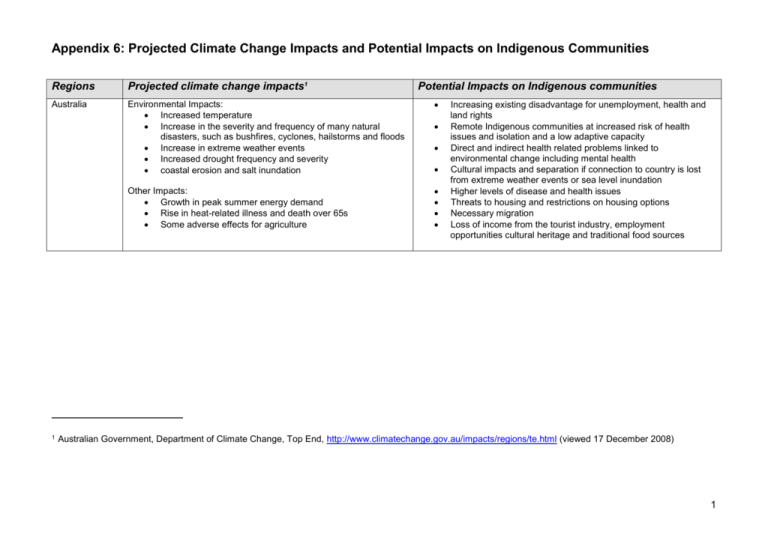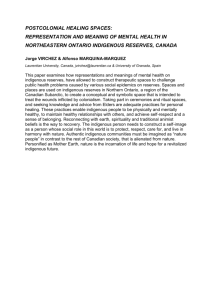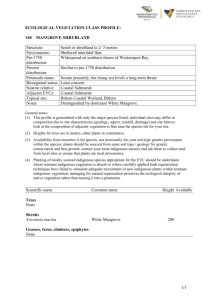in Word - Australian Human Rights Commission
advertisement

Appendix 6: Projected Climate Change Impacts and Potential Impacts on Indigenous Communities Regions Projected climate change impacts1 Australia Environmental Impacts: Increased temperature Increase in the severity and frequency of many natural disasters, such as bushfires, cyclones, hailstorms and floods Increase in extreme weather events Increased drought frequency and severity coastal erosion and salt inundation Other Impacts: Growth in peak summer energy demand Rise in heat-related illness and death over 65s Some adverse effects for agriculture 1 Potential Impacts on Indigenous communities Increasing existing disadvantage for unemployment, health and land rights Remote Indigenous communities at increased risk of health issues and isolation and a low adaptive capacity Direct and indirect health related problems linked to environmental change including mental health Cultural impacts and separation if connection to country is lost from extreme weather events or sea level inundation Higher levels of disease and health issues Threats to housing and restrictions on housing options Necessary migration Loss of income from the tourist industry, employment opportunities cultural heritage and traditional food sources Australian Government, Department of Climate Change, Top End, http://www.climatechange.gov.au/impacts/regions/te.html (viewed 17 December 2008) 1 Regions Projected climate change impacts1 Top End Climate: Tropical Environmental Impacts: More frequent and severe droughts More severe and extreme storm events salt inundation and changes to mangrove ecology Urban water security may be threatened Coastal areas infrastructure and wetlands vulnerable to sea level rise Potential Impacts on Indigenous communities Infrastructure damage Pressure on emergency services in remote communities Heat stress and injuries from storms Indirect impact on species habitat can lead to reduction in protein intake, social dislocation and mental illness or grief due to inability to care for country in Indigenous peoples2 Reintroduction of melioidosis Other Impacts: Spread of vector-borne, water-borne and food-borne diseases Mid Northern Territory Climate: Grassland, Tropical Environmental Impacts: water supply likely to be stressed due to increased demand and climate-driven changes more frequent and severe droughts Extreme storm events. More flash flooding and fires Central Australia Climate: Grassland, Desert Rising sea levels, increased frequency of tropical cyclones and extreme weather events are likely to significantly impact on biodiversity, critical habitats, tourism, food and cultural values important to Indigenous communities Warmer temperatures and increased rainfall variation are likely to increase the intensity of food and water borne diseases. This will particularly affect remote Indigenous communities. E.g. number of Aboriginal children being admitted to hospital with diarrhoea likely to increase by 10 per cent by 20503 Reintroduction of dengue, malaria, diarrhoea, Japanese encephalitis, Murray Valley encephalitis, Ross River fever4 D Green, Climate change impacts on remote Indigenous communities’ health in northern Australia, Climate Change Impacts and Risks CSIRO (2006), p 21. At http://www.sharingknowledge.net.au/files/indigenoushealth_cc200606.pdf (viewed 17 December 2008) 3 Australian Government, Department of Climate Change, Climate Change – Potential Impacts and Costs: Northern Territory, Fact Sheet. At: http://www.climatechange.gov.au/impacts/publications/pubs/fs-nt.pdf (viewed 18 December 2008) 4 D Green, Climate change impacts on remote Indigenous communities’ health in northern Australia, Climate Change Impacts and Risks CSIRO (2006). At http://www.sharingknowledge.net.au/files/indigenoushealth_cc200606.pdf (viewed 17 December 2008) 2 2 Regions Projected climate change impacts1 Potential Impacts on Indigenous communities Environmental Impacts: urban water security may be threatened decline in annual rainfall, higher evaporation increases in extreme storm events Other Impacts: Increase in vector-borne, water-borne and food-borne diseases North Eastern Queensland Climate: Equatorial, Tropical, Subtropical, Grassland Environmental Impacts: Decline in annual rainfall, higher evaporation Reduced run-off to rivers, including Fitzroy and Burnett Stress on water supply, more severe droughts Increase in extreme storms, cyclone damage, flash flooding Great Barrier Reef likely experience significant annual bleaching by 2030 Remote communities particularly vulnerable Food security: increased food prices and loss of environment to secure bush tucker Water security: potential increased aridity and depletion of groundwater Increased risk of heat related illness and death from extreme heat and weather events Communities dependent on tourism may be adversely affected in warmer months Damage to infrastructure Pressure on medical and hospital services More frequent extreme weather and flooding could make isolated Indigenous communities in the far north inaccessible more often Significant water temperature rises and bleaching in the Great Barrier Reef could be devastating for coastal Aboriginal communities with strong links to the sea, particularly if the species affected included totemic animals such as turtles 5 Other Impacts: vector-borne, water-borne and food-borne disease likely increase with predictions Dengue Fever mosquito reaching Rockhampton by 2050 5 Sharing Knowledge, Climate Change Impacts in Northern Australia, http://www.sharingknowledge.net.au/ (17 December 2008) 3 Regions Projected climate change impacts1 Western Queensland Climate: Desert, Grassland, Subtropical Environmental Impacts: Water supply likely to be stressed, higher evaporation, possible decline in annual rainfall Tendency more frequent and severe droughts Increase extreme storm events, more flash flooding and fires Potential Impacts on Indigenous communities Increasing temperatures result in greater risk of heat-related illness and allow mosquitoes to breed in new areas Indigenous peoples’ exposure to new diseases. Increasing temperatures will also affect the frequency and severity of bushfires, challenging fire management practices and potentially endangering lives of Indigenous communities. Other Impacts: possible spread vector-borne disease further south South Eastern Queensland Climate: Subtropical, Temperate Environmental Impacts: increased stress on water supply more frequent and severe droughts, greater fire risk increase in extreme storm events, flash flooding coastal areas vulnerable to sea level rise and inundation Other Impacts: possible spread vector-borne disease further south some adverse effects for agriculture North Western Australia Climate: Tropical, Grassland Environmental Impacts: coastal areas vulnerable to sea level rise and inundation increased stress on water supply more frequent and severe droughts increase in extreme storm events, flash flooding Needs more research Climate change will affect tourism in the Kimberley region, which will consequently affect the livelihood of many indigenous communities dependent on tourism Indigenous communities’ traditional fishing practices will be affected when climate change causes fish populations to deplete substantially6 Other Impacts: some adverse effects for agriculture increase in spread of vector-borne, water-borne and food- 6 Sharing Knowledge, Climate Change Impacts in Northern Australia, http://www.sharingknowledge.net.au/ (17 December 2008) 4 Regions Projected climate change impacts1 Potential Impacts on Indigenous communities borne disease. Mosquito carries Dengue Fever possibly reach Port Hedland by 2050 Mid Western Australia Climate: Desert, Grassland Increased risks of food and water-borne diseases in remote Indigenous communities due to rising temperatures Environment Impacts: coastal areas vulnerable to sea level rise and inundation urban water security may be threatened more frequent and severe droughts increase in extreme storm events, flash flooding Other Impacts: Increase in spread of vector-borne, water-borne and foodborne disease. Mosquito carries Dengue Fever may reach Carnarvon by 2050 South Western Australia Climate: Temperate, Subtropical, Grassland Needs more research Environmental Impacts: coastal areas vulnerable to sea level rise and inundation increased stress on water supply possible decline in annual rainfall and highly evaporation, likely to reduce runoff to rivers including Canning and Thompson Brook by 2030 possible 30 percent decline in runoff to Stirling catchment by 2050 more frequent and severe droughts increases in extreme storm events Other Impacts: vector-borne, water-borne and food-borne disease may be spread further south some adverse effects for agriculture South Eastern Western Climate: Desert, Grassland Environmental Impacts: Needs more research 5 Regions Australia Mid South Australia Southern South Australia Projected climate change impacts1 Potential Impacts on Indigenous communities increased temperatures increased stress on water supply more frequent and severe droughts increases in extreme weather events, flash flooding coastal areas vulnerable to sea level rise and inundation Other Impacts: spread of vector-borne, water-borne and food-borne disease Climate: Desert, Grassland Environmental Impacts: increased stress on water supply more frequent and severe droughts increase in extreme weather events Other Impacts: spread of vector-borne, water-borne and food-borne disease Climate: Grassland, Temperate Environmental Impacts: urban water security may be threatened decline in annual rainfall and higher evaporation, projected decline of 0-25 percent for Scott Creek by 2030 increases in extreme storm events coastal areas vulnerable to sea level rise and inundation CO2 benefits experienced by forestry may be offset by decline in rainfall, more bushfires and changes in pests Needs more research Needs more research Other Impacts: spread of vector-borne, water-borne and food-borne disease some adverse impacts for agriculture New South Wales Climate: Temperate, Subtropical, Grassland, Desert Environmental Impacts: threats to urban water security Despite the utilisation of wildlife for livelihood being more common in remote communities, the loss of access to agricultural resources and wildlife could also adversely affect economic 6 Regions Projected climate change impacts1 Potential Impacts on Indigenous communities development of Indigenous communities in settled coastal regions of New South Wales7 less runoff in rivers in many catchments. Murray-Darling Basin decrease of 10-25 percent by 2050. More frequent and severe droughts, greater fire risk 10-40 percent reduction in snow cover by 2020: impact for ecosystems and alpine tourism CO2 benefits experienced by forestry may be offset by decline in rainfall, more bushfires and changes in pests increases in extreme storm events coastal areas vulnerable to sea level rise and inundation Other Impacts: spread of vector-borne, water-borne and food-borne disease further south some adverse impacts for agriculture Victoria Climate: Temperate, Grassland Environmental Impacts: threats to urban water security decline in annual rainfall , higher evaporation likely reduce run-off to rivers by up to 45 percent 10-40 percent reduction in snow cover by 2020: impact for ecosystems and alpine tourism Increases in extreme storm events coastal areas vulnerable to sea level rise and inundation CO2 benefits experienced by forestry may be offset by decline in rainfall, more bushfires and changes in pests Indigenous people living in remote communities are at increased risk with the number of Aboriginal children being admitted to hospital with diarrhea likely to increase by 10 per cent by 2050 8 Decreased yields in agriculture would affect the economic development of Indigenous communities 7 Altman JC & Jordan K, Impact of Climate Change on Indigenous Australians: Submission to the Garnaut Climate Change Review, CAEPR Topical Issue No.3/2008, Centre for Aboriginal Policy Research, Australian National University (2008). At: http://www.anu.edu.au/caepr/Publications/topical/Altman_Jordan_Garnaut%20Review.pdf (viewed 18 December 2008) 8 Australian Government, Department of Climate Change, Climate Change – Potential Impacts and Costs, Victoria Fact Sheet. At: http://www.climatechange.gov.au/impacts/publications/fs-vic.html (viewed 18 December 2008). 7 Regions Projected climate change impacts1 Potential Impacts on Indigenous communities Other Impacts: spread of vector-borne, water-borne and food-borne disease further south some adverse impacts for agriculture Tasmania Climate: Temperate Needs more research Environmental Impacts: threats to urban water security increase in annual rainfall , higher evaporation lead to uncertain effects on run-off into rivers 10-40 percent reduction in snow cover by 2020: impact for ecosystems and alpine tourism Increases extreme storm events CO2 benefits experienced by forestry may be offset by decline in rainfall, more bushfires and changes in pests Other Impacts: spread of vector-borne, water-borne and food-borne disease further south some adverse impacts for agriculture 8







